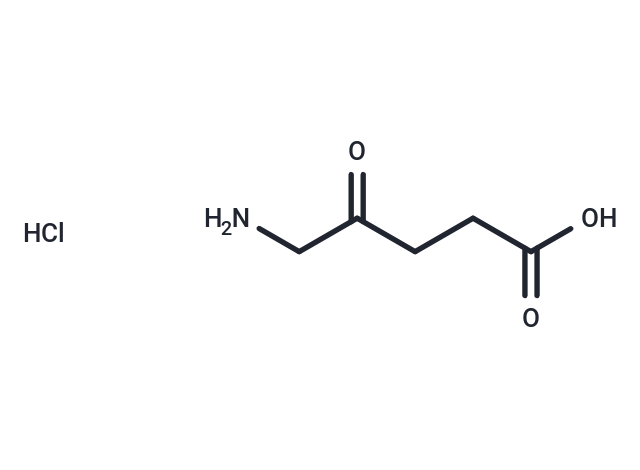Shopping Cart
- Remove All
 Your shopping cart is currently empty
Your shopping cart is currently empty

5-Aminolevulinic acid hydrochloride (5-ALA) is an intermediate in heme biosynthesis and a universal precursor of tetrapyrroles.

| Pack Size | Price | Availability | Quantity |
|---|---|---|---|
| 50 mg | $33 | In Stock | |
| 100 mg | $46 | In Stock | |
| 200 mg | $48 | In Stock | |
| 1 g | $67 | In Stock | |
| 5 g | $179 | In Stock | |
| 10 g | $271 | In Stock | |
| 1 mL x 10 mM (in DMSO) | $48 | In Stock |
| Description | 5-Aminolevulinic acid hydrochloride (5-ALA) is an intermediate in heme biosynthesis and a universal precursor of tetrapyrroles. |
| In vitro | 5-Aminolevulinic acid (5-ALA), a non-fluorescent prodrug, facilitates the intracellular build-up of fluorescent porphyrins in malignant gliomas, aiding in their intraoperative identification and removal. A study with a median follow-up of 35.4 months (95% CI 1.0-56.7) showed that 65% (90 out of 139) of patients treated with 5-ALA achieved complete resection of contrast-enhancing tumors, compared to only 36% (47 out of 131) in those using white light, marking a significant difference of 29% (95% CI 17-40, p<0.0001). Additionally, those treated with 5-ALA exhibited a higher 6-month progression-free survival rate of 41.0% (32.8-49.2) versus 21.1% (14.0-28.2) for the white light group, a difference of 19.9% (9.1-30.7, p=0.0003, Z test). However, 5-ALA alone was deemed insufficient for achieving gross total resection without risking postoperative neurological damage. In treating functional grade III gliomas, the combination of intraoperative MRI (iMRI) with functional neuronavigation significantly outperformed the 5-ALA resection technique. |
| Alias | Hydrangin, ALA hydrochloride, 5-Aminolevulinic acid HCl, 5-ALA |
| Molecular Weight | 167.59 |
| Formula | C5H10ClNO3 |
| Cas No. | 5451-09-2 |
| Smiles | Cl.NCC(=O)CCC(O)=O |
| Relative Density. | no data available |
| Storage | store at low temperature,store under nitrogen,keep away from moisture | Powder: -20°C for 3 years | In solvent: -80°C for 1 year | Shipping with blue ice. | ||||||||||||||||||||||||||||||||||||||||
| Solubility Information | H2O: 31 mg/mL (184.98 mM), Sonication is recommended. Ethanol: 6 mg/mL (35.8 mM), Sonication is recommended. DMSO: 45 mg/mL (268.51 mM), Sonication is recommended. | ||||||||||||||||||||||||||||||||||||||||
Solution Preparation Table | |||||||||||||||||||||||||||||||||||||||||
Ethanol/H2O/DMSO
H2O/DMSO
| |||||||||||||||||||||||||||||||||||||||||

Copyright © 2015-2025 TargetMol Chemicals Inc. All Rights Reserved.